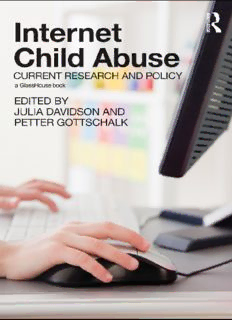
Internet Child Abuse: Current Research and Policy PDF
Preview Internet Child Abuse: Current Research and Policy
Internet Child Abuse InternetChildAbuse:CurrentResearchandPolicyprovidesatimelyoverview ofinternationalpolicy,legislationandoffendertreatmentpracticeinthearea of Internet child abuse. Internet use has grown considerablyoverthe last five years, and information technology now forms a core part of the formal education system in many countries. There is, however, increasing evidence that the Internet is used by some adults to access children and young people in order to ‘groom’ them for the purposes of sexual abuse; as well as to produce and distribute indecent illegal images of children. This book pre- sents and assesses the most recent and current research on Internet child abuse, addressing: its nature, thebehaviour and treatment ofits perpetrators, international policy, legislation and protection, and policing. It will be required reading for an international audience of academics, researchers, policy makers and criminal justice practitioners with interests in this area. Julia Davidson is Professor of Criminology and Sociology and Director of Social Researchat Kingston University; she is also Co-Directorof the newly formed Centre for Abuse & Trauma Studies. Petter Gottschalk is Professor of Information Systems and Knowledge Management in the Department of Leadership and Organization at the Norwegian School of Management, and he lectures at the Norwegian Police University College on knowledge management, the Internet, criminal entrepreneurship and organised crime. Internet Child Abuse Current Research and Policy Edited by Julia Davidson and Petter Gottschalk Firstpublished2011 byRoutledge 2ParkSquare,MiltonPark,Abingdon,Oxon,OX144RN SimultaneouslypublishedintheUSAandCanada byRoutledge 270 Madison Avenue, New York, NY 10016 AGlassHousebook RoutledgeisanimprintoftheTaylor&FrancisGroup,aninformabusiness This edition published in the Taylor & Francis e-Library, 2010. To purchase your own copy of this or any of Taylor & Francis or Routledge’s collection of thousands of eBooks please go to www.eBookstore.tandf.co.uk. ©2011editorialmatterandselectionJuliaDavidsonandPetterGottschalk; individualchapters©thecontributors Allrightsreserved.Nopartofthisbookmaybereprintedorreproducedor utilisedinanyformorbyanyelectronic,mechanical,orothermeans,now knownorhereafterinvented,includingphotocopyingandrecording,orinany informationstorageorretrievalsystem,withoutpermissioninwritingfrom thepublishers. BritishLibraryCataloguinginPublicationData AcataloguerecordforthisbookisavailablefromtheBritishLibrary LibraryofCongressCataloguinginPublicationData Internetchildabuse:currentresearchandpolicy/ editedbyJuliaDavidsonandPetterGottschalk. p.cm. ISBN978-0-415-55980-5 1.Childsexualabuse–Prevention.2.Childsexualabuse–Psychological aspects.3.Onlinesexualpre dators–Psychology.4.Childmolesters– Psychology.5.Childpornography–Lawandlegislation.6.Internetandchildren. I.Davidson,JuliaC.II.Gottschalk,Petter,1950- K5189.I592010 364.15’36–dc22 2010002180 ISBN 0-203-84743-1 Master e-book ISBN ISBN13:978-0-415-55980-5(hbk) ISBN 13: 978-0-20-384743-5 (ebk) Contents Editors’ note ix Notes on contributors x Introduction 1 JULIADAVIDSONANDPETTERGOTTSCHALK Context and relevance 1 Book structure 3 Notes 6 References 6 1. Legislation and policy: protecting young people, sentencing and managing Internet sex offenders 8 JULIADAVIDSON Introduction: young people’s online behaviour 8 Legislation: online grooming 9 Indecent images of children 12 The relationship between indecent image collection and contact offending 16 Sentencing of Internet sex offenders 17 Internet sex offenders: assessing and managing the risk – the UK example 18 The effectiveness of UK multi-agency public protection arrangements in monitoring Internet sex offenders 20 Conclusion 22 Notes 23 References 24 Legislation 26 Cases 26 vi Contents 2. Characteristics of the Internet and child abuse 27 PETTERGOTTSCHALK Introduction: understanding the Internet 27 Seventeen Internet characteristics 28 The role of web cams 35 Technology behind MySpace 35 Virtual communities 37 Understanding online groomers 42 Understanding children’s online behaviour 45 Perspectives on child sexual abuse 47 Internet crime 48 Conclusion 49 Notes 49 References 49 3. Combating child abuse images on the Internet: international perspectives 52 JOHNCARRANDZOEHILTON Introduction and context 52 The link between possession and contact offending 53 Step change in the scale of production and distribution 54 A child’s legal right to protection 55 Political initiatives at EU level and beyond 56 Report of the International Center for Missing and Exploited Children 59 Practicalities of law enforcement investigations 61 International law enforcement activity 62 New technology to support police work and help protect children 64 Disruption methods 65 Slow takedown times 65 Blocking technology – reducing the availability of child abuse images 67 Creating a unified list of websites of child abuse material 69 The Financial Coalition Against Child Pornography 70 The lack of international political mechanisms: ICANN’s role 71 Victim identification and care 71 Slow progress on victim identification despite joint working 72 Ongoing care for children 73 Conclusion 73 Notes 74 References 78 Contents vii 4. Stage model for online grooming offenders 79 PETTERGOTTSCHALK Introduction 79 Stages of growth models 80 Online grooming offence 81 Stages of online offending 83 Police investigations 91 Internet red buttons 93 Sex offender progression 99 References 100 5. Understanding the perpetrators’ online behaviour 104 ELENAMARTELLOZZO Introduction 104 Background and context 104 Methodology 106 Offenders creating a profile 106 Hyper-confident groomers 107 The hyper-cautious groomer 108 Understanding online offenders 109 Case study: an offender operationalising a profile 110 Offender research: justifying the offence 111 Exploring discovery 112 Exploring denial 114 Denial and indecent images 116 Exploring distorted attitudes towards children 118 Exploring sex offenders’ adult relationships 120 Conclusion 121 Notes 122 References 122 6. Policing social networking sites and online grooming 126 JONTAYLOR Introduction 126 Historical context of Internet abuse and policing 126 Social networking sites 127 Policing child sexual abuse online 129 Covert police operations 131 Contact offending and non-contact offending 132 Findings: researching offender online behaviour 134 Policing contact offences and non-contact offences in the virtual world 139 viii Contents Policing online child sexual abuse 143 Reactive policing of online CSA 145 Proactive policing of online CSA 145 Proactive reactive policing of online CSA 146 Conclusion 146 Notes 148 References 149 7. Assessment and treatment approaches with online sexual offenders 153 MATTO’BRIENANDSTEPHENWEBSTER Introduction 153 Assessing online sexual offenders: ethical challenges 154 Collaborative assessments and readiness 155 Assessment methods 157 Social history and psychological functioning 157 Indecent image content 158 Static and dynamic risk 159 Cognitive and behavioural functioning 160 Future directions 162 Treatment targets for online sexual offenders 163 Specifically tailored approaches to treatment 167 i-SOTP 167 Other emerging tailored treatment programmes 170 Other (non-group based) approaches 175 Strategies employed to address problematic Internet use 177 Conclusion 178 References 178 Conclusion 186 JULIADAVIDSONANDPETTERGOTTSCHALK References 188 Index 190 ’ Editors Note This book has sought to avoid the use of the word ‘paedophile’; the term ‘sex offender’ is used as an alternative. The term paedophile refers to those who have a sexual attraction to only pre-pubescent children; the term has become a popular label that includes all types of child sexual abuse.
